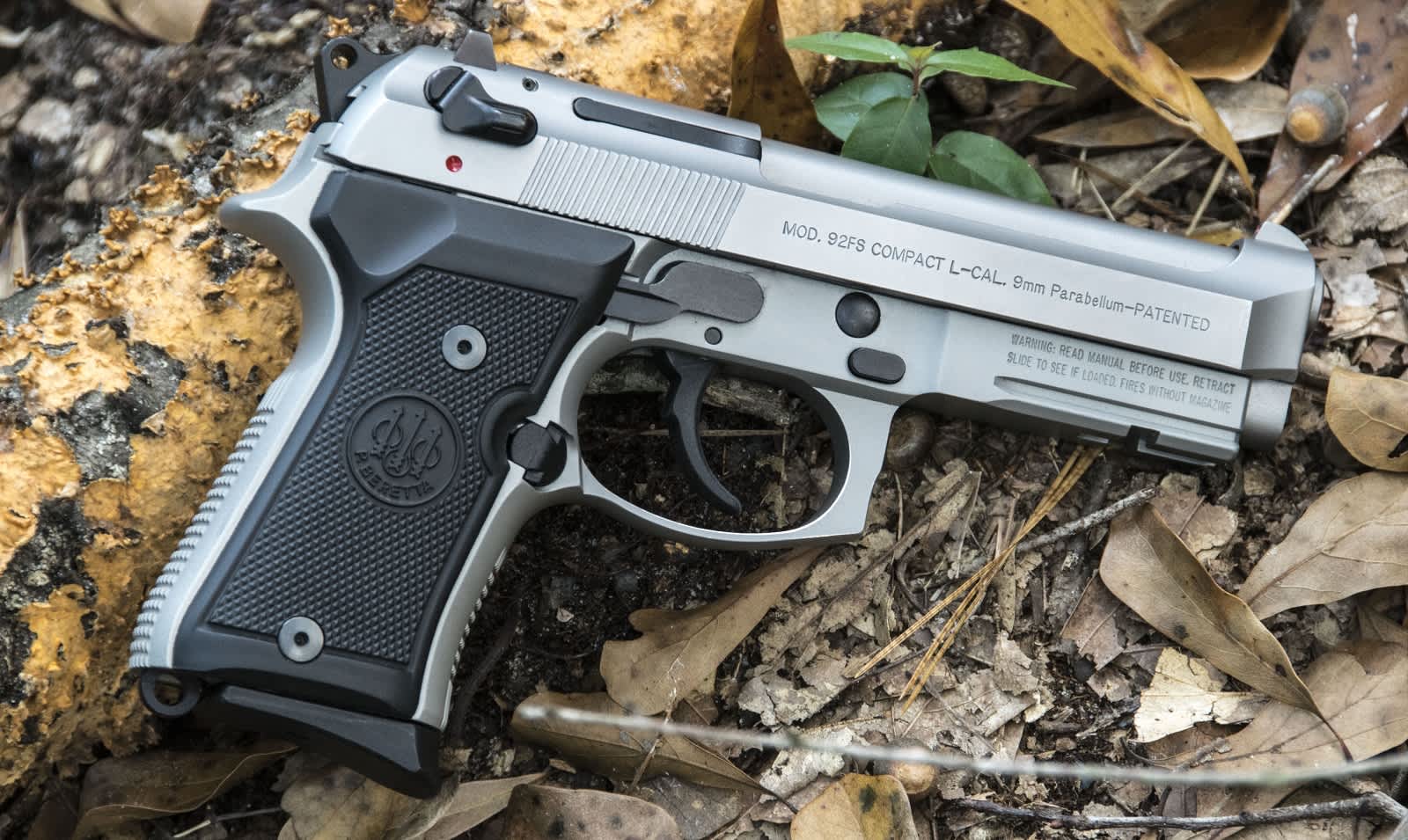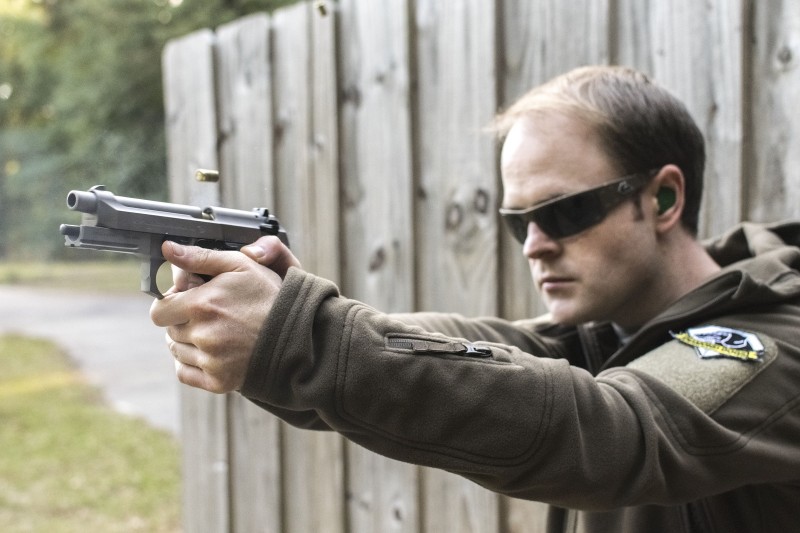Beretta M9A1 Compact Inox
Jim Grant 11.18.15

The Beretta M9, also known as the Beretta 92 Compact, is a gun with a reputation. This makes reviewing it very tricky. Anyone qualified to judge it is familiar with the design’s shortcomings and virtues. In many ways reviewing an M9 of any variety is like reviewing a 1911: both have dedicated groups of believers and haters. The only way to give an M9 variant a fair shake is to compare it against its peers and judge it according to the role its current iteration is meant to fill.
Enter the Beretta M9A1 Compact Inox. Its specs are as follows:
- Caliber: 9x19mm
- Action: Single/Double
- Length: 7.75 inches
- Height: 5.25 inches
- Width: 1.5 inches
- Barrel length: 4.25 inches
- Weight unloaded: 31.6 ounces
- MSRP: $800
The Beretta M9A1 Compact series of pistols are an abridged variant of their full-sized big brothers. They still utilize the same open-slide, exposed-barrel configuration secured via a locking wedge that swings vertically. Gun geeks and historical firearm enthusiasts will recognize this as a derivative of the Walther P38’s design. Unlike the Walther, the M9 uses a double-stack magazine and push-button magazine release.
Full-sized M9 magazines hold 15 rounds, while the slightly shorter compact versions have a 13-round capacity. In testing, these are easy to load and fed flawlessly in the Beretta. This was across 550 rounds of various ammunition types including lead-free frangibles, NATO-spec 124-grain FMJ, and high-end Hornady and Winchester defensive ammo. Just like the full-size model, the compact’s wide backstrap and impressive heft soak up the majority of felt recoil. Making it a great pistol for extended plinking trips to the range.
The Inox portion of the M9’s handle indicates that it has a stainless finish. I personally feel that the pistol looks better with the Inox finish over standard blued coatings, but it does have a downside. Shooters looking to carry the Compact Inox need to ensure the handgun is completely concealed when on them. While this is unarguably true with any carry pistol, a flashy stainless finish is more easily spotted than a black or blued one.
Before I continue, it’s important to address the 800-pound gorilla in the room: M9 longevity and reliability. I do this not simply to establish my credibility in reviewing this product, but to demonstrate how overstated it is. It’s an established fact that the average lifespan of a Beretta-made M9 handgun is around 35,000 rounds.

It’s important to note that these pistols are subjected to abhorrent conditions and rarely see timely maintenance. For shooters who feel that this number is still too small, think about the average shooter. Most rarely put more than 500 rounds through their pistol a year. At that rate, the M9 will last them 70 years without a major breakage. While this is a best-case scenario, more prolific shooters need only replace action springs and other minor parts to keep their Italian stallion running long past that benchmark.
Eleven-syllable title aside, there’s nothing complex about this design, which is a tremendous compliment given its designated role. As a compact pistol, its primary function is as a concealed carry handgun or mid-sized home-defense pistol.
As a concealed carry pistol, the Beretta M9A1 Compact is a great, but imperfect choice. While it’s easy to fire accurately, reliable, and soft-shooting, the Beretta M9A1 is a little too heavy to comfortably carry without a quality holster and rugged gun belt. As someone who used to regularly carry a full-size M1911 with four spare magazines, I didn’t find the weight bothersome—but shooters accustomed to polymer micro-pistols will find the Beretta a finely-made, Italian brick after a few hours of carrying.
Simplistic as it may be, certain aspects of that design could stand to be improved. The slide-mounted safety would be better positioned on the frame and the open-slide design allows debris to enter the action. However, the open design of the slide also allows that same debris to easily be removed.
Though Beretta didn’t simply rehash the design, they did improve it over previous versions. The most obvious change is the shortened barrel and grip. More observant shooters will quickly recognize the railed dust cover beneath the muzzle that allows shooters to mount accessories like tactical lights or lasers.
One unexpected improvement that I really enjoyed are the two-tone iron sights. While they still retain their red paint-filled indents, the post-and-notch-style sights are different from the regular M9. The rear sight notch is of standard construction, but the front sight post is different.

Whereas the rear sight features a matte black coating, the front utilizes the same satin Inox finish as the rest of the gun. This makes finding the front sight and keeping a shooter’s dominant eye fixed on it effortless. This is especially important when drawing from a holster in low-light conditions, in which adrenaline often makes shooters forget their training.
In testing, the Beretta M9A1 Compact Inox proved more accurate than most test shooters, achieving sub-two-inch groups at 15 yards with Hornady 147-grain XTP defensive ammo. Shooters with good eyesight made regular hits on a 12-inch steel gong at 100 yards while standing. Most also commented on how minimal the recoil felt compared to polymer pistols of the same size.
The only thing my test shooters didn’t love about the Beretta was the double-action trigger, but not because it was particularly heavy or long. Most newer shooters learn on striker-fired pistols, which have a consistent trigger pull every time. It wasn’t the heft of the pull that bothered them so much as the fact that subsequent pulls are so different—though this is a matter of training rather than a design flaw. That said, the single-action pull is crisp, and everyone, myself included, felt it was conducive to accurate, rapid firing.
The M9A1 Compact is anachronistic in many ways among the dozens of striker-fired polymer-framed handguns on the market. Shooters looking for something a little different, or soldiers returning from overseas who want a smaller, more modular version of the service pistol, will find the Beretta M9A1 Compact Inox fits the role perfectly.

